1977 Japanese Grand Prix race report
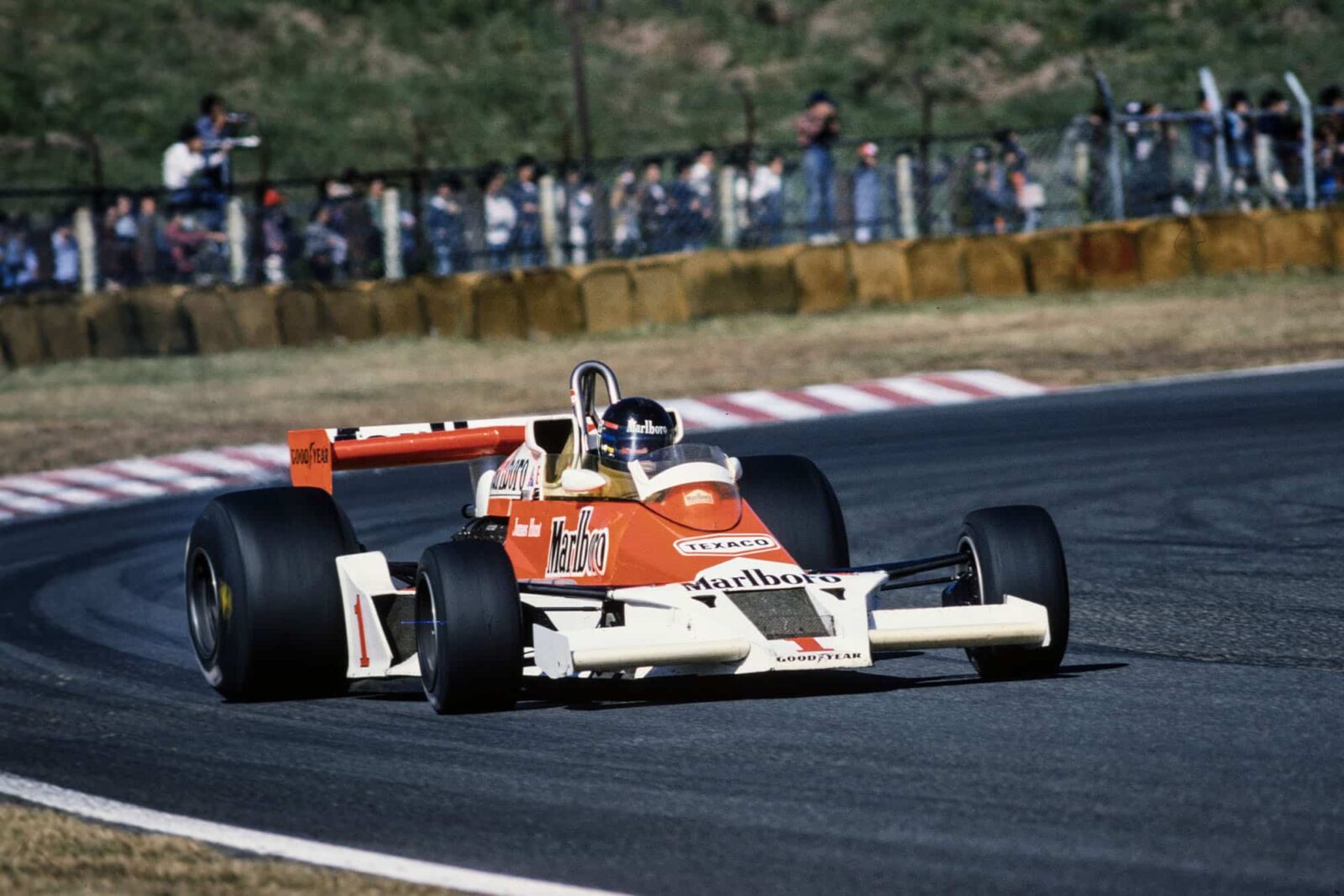
James Hunt brought some consolation to a difficult '77 with a win at the season finale
Motorsport Images
Hunt leaves no doubt
Fuji Speedway, October 23rd
Although the Japanese Grand Prix is a new event to the Formula One World Championship series, a race under that title was first held as long ago as 1963. Then it was won by a certain P. Warr at the wheel of one of Colin Chapman’s little Lotus 23B sports racing cars. That of course was Peter Warr, then a keen amateur racing driver, and more recently known for his role of team manager at Team Lotus and, from the start of 1977, Walter Wolf Racing. In 1963 the race was held at the Suzuka circuit and now, after two World Championship races at the Mount Fuji Speedway, there is every indication that the 1978 Japanese Grand Prix will return to Suzuka.
The 1976 Japanese Grand Prix provided the organisers with a “fairy tale” finish to the World Championship as James Hunt snatched the drivers’ title by the proverbial whisker and Mario Andretti put Chapman’s Lotus team back in the winner’s circle after a two year drought. This year things were different, and the organisers accepted that they were unlikely to be blessed with such a spectacular finale to the season as that enjoyed in 1976. However they were obviously, and justifiably, disappointed when they were deprived of 1977 FIA Points Champion Niki Lauda on the basis of the Austrian’s personal whim, in addition to former Champion Emerson Fittipaldi whose Brazilian financed team felt that they would be wasting their time going all the way to Japan for another disappointing performance. It was understandable that the Fittipaldi team saw a programme of testing in Britain as a much more sensible alternative to competing in japan and they were only exercising their F1 Association right to miss one race “outside Europe”. However, with the French Renault RS01 also failing to make the trip along with Hesketh Racing and most of the “privateers”, the Japanese Grand Prix had something of a “Race of Champions” atmosphere about it!
Compensating for loss of some of the international interest, there were three Japanese drivers in the race. Noritake Takahara and Kazuyoshi Hoshino were entered at the wheel of locally built Kojima 009s, developments of the very promising 007 version driven by Hasemi in last year’s race. The two Kojimas were fitted with Bridgestone tyres and Hoshino will be remembered as something of a “local star” in last year’s Grand Prix, working his Tyrrell 007 up into third place during the race’s early rain-soaked stages before being forced to retire for the unusual reason that his pit had run out of fresh Bridgestone tyres! Hoshino’s old Tyrrell appeared again at Fuji in the hands of Kunimitsu Takahashi, this time running on Japanese Dunlop tyres.
On the regular Formula One front there were still some driver changes to be seen in the dying moments of the Grand Prix year. Ian Scheckter arrived at Tokyo’s Haneya airport only to find that he was not going to be granted admittance to Japan on the particular visa that he had been issued with. After a day or so of wrangling the elder Scheckter brother was on a plane back to London without having left the airport area. This unfortunate “mess up” in March’s paperwork meant that their second entry, the Rothmans-sponsored 771, was to remain vacant for the entire weekend, something that did not seem to bother March director Max Mosley unduly much since he was just about at the end of his tether with the disappointing way things have been going for his organisation this season.
In the Ligier camp there was a second entry for Jarrier at the wheel of Laffite’s spare car JS/ 03, possibly in anticipation of a second entry from this team in 1978, but otherwise all the usual drivers were in all their usual cars. Watson’s damaged Brabham BT45/6B and Nilsson’s Lotus 78/4 had both been straightened out following their accidents at Mosport Park, although the Swede’s car was painted in a red and gold pinstripe livery instead of its customary black and gold. Hunt was allocated the rebuilt M26/1 which had been built up out of a box of spares following his Mosport tangle with Mass while Patrese took over the Shadow team’s spare DNS/3A after his usual car was wrecked in his Mosport accident. The Wolf team sent WR2 home and brought out WR3 from Britain to pair with WR1 for Jody Scheckter’s use in the Japanese Grand Prix and both Surtees TS19S for Brambilla and Binder were back together again after their Mosport accidents!
Qualifying
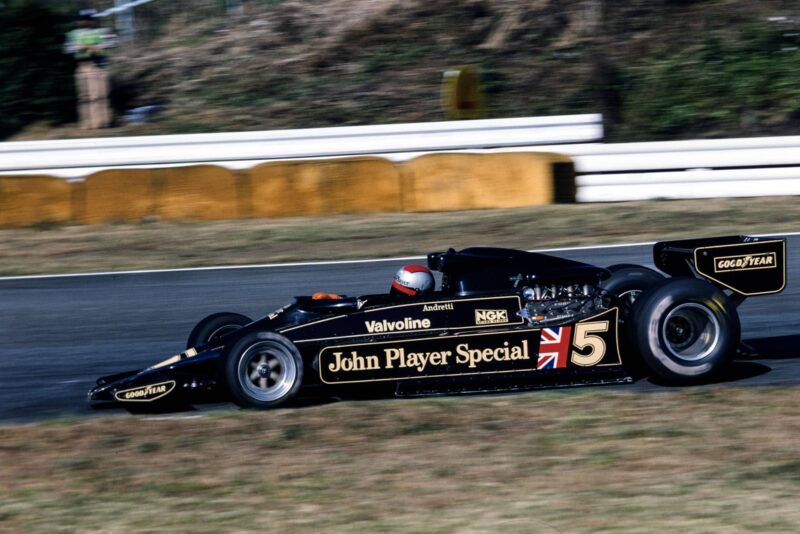
Mario Andretti took pole for Lotus
Motorsport Images
After the circuit doctor was late in arriving for the start of the timed practice on Friday morning it did not take long for all the teams to agree to amalgamate the first two practice sessions and have a single two-hour stint between mid-day and 2 o’clock in the afternoon. Concern about the durability of Goodyear’s softest tyre compound on Fuji’s abrasive track surface didn’t prevent most people from starting off using it although things were to look distinctly marginal once they began testing with full fuel loads on Saturday morning.
Andretti started off as he meant to continue, romping round this circuit, on which he scored his first Lotus victory, in 1 min. 12.23 sec., which was soon followed up by a determined James Hunt who got down to 1 min. 12.39 sec. After a few laps in his “new” car, the deposed World Champion decided that he didn’t like the amount of understeer it developed under power so he exercised his right as team leader by commandeering team-mate Mass’s M26/3 for the rest of the weekend. Hunt later remarked that his fresh car was much better but that the steering was a bit on the heavy side; ” Jochen has got stronger arm muscles than I have.”
Despite having to stop every half-dozen laps or so to top up his Alfa flat-12 with more water, Watson looked very competitive with a 1 min. 13.20 sec. best which was marginally faster than Stuck could manage in his healthy car (1 min. 13.33 sec.). Optimistic timing initially credited Jarier with a remarkable 1 min. 13.23 sec. lap which might well have left him fourth fastest overall had it been correct. Unfortunately for the French driver it wasn’t and Jarier’s time was subsequently amended to 1 min. 14.25 sec.
In the Ferrari camp there was nothing but gloom and despondency from Reutemann, despite the Argentinian managing 1 min. 13.37 sec., and a look of near bewilderment from young Villeneuve. Both drivers reckoned that the cars were quite simply “awful”. Every time they touched the throttles the rear end slipped and swayed about all over the circuit. They were so twitchy that they could barely take the long right hander onto the start/finish straight without lifting off. It was a lesson to those who thought that Ferrari drivers had an easy time and simply drove round “on rails”. On the face of it it looked very much as though the Italian team were missing Lauda’s analytical approach, but the Austrian driver had chosen not to come to Japan following his fourth place finish at Watkins Glen which ensured him the World Championship title on points.
Hoshino managed an extremely respectable 1 min. 13.55 sec. best on his soft “qualifying” Bridgestone tyres with the Kojima, which was quicker than Nilsson in the second Lotus (1 min. 13.66 sec.) and Mass in the second McLaren (1 min. 13.71 sec.). Clay Regazzoni was enjoying himself in the Ensign and managed a 1 min. 13.72 sec. before it ran out of petrol and Jones was hampered by the same understeer about which he had complained in Canada, taking the faster of the two Shadow DN8s round in 1 min. 13.90 sec. Team-mate Patrese had a disappointing day, ending up with a best of 1 min. 14.02 sec. after a shock-absorber mounting bolt came undone at the rear of the car and sent him on an unexpected trip up the escape road at the end of the start/finish straight. Experiments with harder compound tyres on Saturday morning convinced Andretti, at least, that he would have to stick to the soft compound rubber for the race. During the untimed session which did not count for grid positions Andretti found that the harder tyres totally ruined the car’s balance and endowed it with so much understeer that he reckoned the front tyres would wear out anyway before the end of the race even if he did use the harder rubber.
The times established by Andretti and Hunt in the first session were quite adequate to ensure that they remained on the front row for Sunday’s race as nobody improved upon those times during the final hour of timed practice. Watson came very close with a 1 min. 12.49 sec. while Stuck improved to 1 min. 13.01 sec. to ensure that both Brabham-Alfa Romeos started from the second row of the grid.
Despite endless problems on the First day with fuel mixture adjustments, a problem that hampered both Ligier’s progress, Laffite qualified fifth with 1 min. 13.08 sec. ahead of Jody Scheckter who had a very troubled time throughout practice. He started off at the wheel of Wolf WR3 on Friday but by the time he had got the cockpit adjustments sorted out to his liking and got into the swing of things the car’s gearbox packed up owing to a fault in its assembly back in England. This meant that Scheckter was obliged to continue practising in Wolf WR1, but that promptly blew up its engine after less than a dozen laps which meant that he was back in the newer car on Saturday. His 1 min. 13.15 sec. best was achieved despite all these problems and the South African driver remained highly optimistic about his chances once the race got under way.
Reutemann tried consistently hard with his ill-handling Ferrari, eventually gaining a position on the inside of The fourth row with a 1 min. 13.32 sec., a fraction faster than Mass’s best in the other McLaren M26. Villeneuve was doing his best in the second Ferrari but that really was not good enough and the French Canadian newcomer was eventually consigned to a grid position right down at the back of the grid with only one of the Japanese, Binder and Ribeiro behind him. Reflecting wistfully about his drive at the wheel of a McLaren M23 in this year’s British Grand Prix. Villeneuve did not face the Japanese Grand Prix with an air of excessive optimism!
The fifth row was made up of that potentially explosive duo Brambilla 1 min. 13.52 sec.) and Regazzoni (1 min. 13.52 sec.), the combination of which was devastatingly underlined during the opening laps of the Spanish Grand Prix earlier in the year. Nudging in behind, right in amongst the established mid-field runners, was Hoshino’s Kojima 009 1 min. 13:55 sec.) ahead of the Shadows of Jones 1 min. 13.56 sec.) and Patrese (1 min. 13.58 sec.), the two cars from Northampton facing the race from their now customary mid-field starting positions.
Nilsson qualified the second Lotus 78 on 1 min. 13.66 sec., while Depailler was the faster of the two Tyrrell drivers, the six wheel machines sandwiching Tambay’s Ensign and Jarier. Although Patrick was trying as hard as he knew, one got the impression that Peterson was happy that the season was almost over. As it was there was to be yet another slice of unexpected excitement awaiting the Swedish driver once the race got under way.
Takahara pipped Villeneuve, while Binder complained about an un-nerving degree of high speed understeer in his Surtees and Takahashi seemed always to be Spinning his Tyrrell when one looked up. Right at the back came little Alex Ribeiro in the lone factory March, almost three full seconds away from Andretti’s pole position time. Neither he, nor his entrants, looked as though they cared by this stage in the season ….
Race
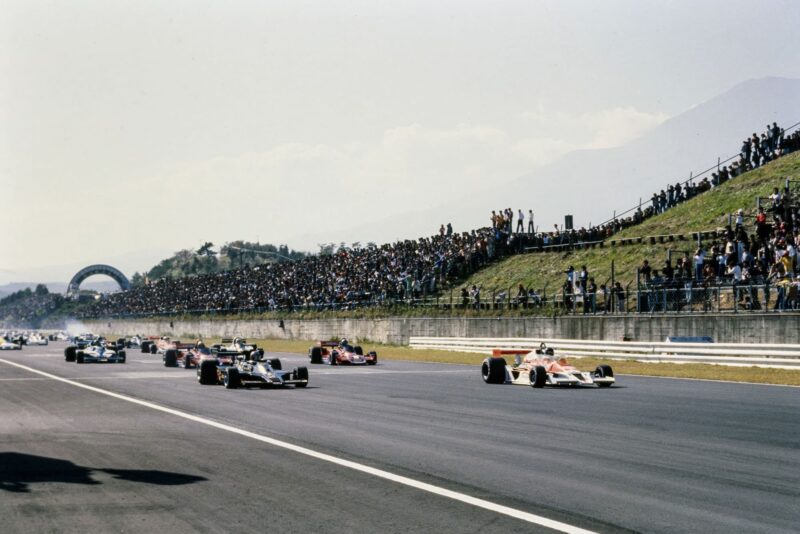
The race starts
Motorsport Images
In stark contrast to last year’s diabolical weather, this year’s race was run in superbly bright conditions with a warm sun overhead and a cloudless sky in all directions. The race started exactly on time, another contrast with last year’s rain-soaked event.
Anxious to show everybody his true capabilities, James Hunt made an absolutely tremendous start and led down into the first right hand corner while Andretti let the revs drop away and his lotus was swallowed up by a great horde of rival F1 machinery. Scheckter and Regazzoni did excellent starts as well, the Wolf slotting into second place with Mass just displacing the Swiss driver’s Ensign for third when he slid the number two McLaren, brakes locked up, through on the inside of the first corner.
At the end of the first lap Hunt was away on his own already. Second was Scheckter, then Mass, Regazzoni, Watson, Lane, Stuck, Andretti, Reutemann, Brambilla, Hoshino, Patrese, Nilsson, Jones, Depailler, Peterson, Villeneuve, Takahashi, Tambay, Jarier, Takahara, Binder and Ribeiro. Andretti was really annoyed about his tardy start and rocketed past Stuck at the end of the start/finish straight. Unfortunately the rugged little American driver rather overdid things half way round his second lap as he tried to run round the outside of Laffite’s Ligier as they rounded the long right-hand corner that leads into the left-hand hairpin behind the pits. With the French driver moving over to the outside of the circuit on the exit of the corner, his legitimate racing line, Andretti’s right front wheel came into sharp contact with the Ligier’s left rear and in an instant the Lotus was sailing across the grass run-off area into the guard rail. The 78 shed its left rear wheel as it hit the guard rail, bouncing this back into the path of Takahara’s Kojima which made quite firm contact and eliminated the Japanese car from the race. Binder’s Surtees also spun in this debacle, catching debris from the accident and sliding onto the grass into retirement as well.
All this fuss allowed Hunt to get well clear and within seven laps Mass moved past Scheckter’s Wolf to leave us the imposing sight of the two McLaren M26s running in 1-2 formation. Watson quickly followed Mass through into third place as Scheckter dropped away, his Wolf understeering too acutely for the South African driver to maintain his place with the leading bunch. Close behind, pressing him hard, was Regazzoni while Stuck was busy holding up a huge bunch consisting of Reutemann, Brambilla, Lane, Nilsson and the two Shadows. Jarier’s hopes for a good result in the I.igier came to an end after three laps when something went badly wrong inside the Matra V12 and he was forced to retire.
As Hunt set a cracking pace up at the front, things were going badly wrong down at the back of the field. Going into his sixth lap, Villeneuve inadvertently left his braking too late at the end of the start/finish straight and ran his Ferrari into the back of Peterson’s Tyrrell. The Italian car climbed up over the six wheeler, knocking off its rear wing in the process, before launching Villeneuve into a heart-stopping series of end-over-end somersaults. The Ferrari was totally destroyed during its crazy flight which unfortunately ended over the top of a track side guard rail and in amongst some onlookers in a prohibited area. Villeneuve is a little chap and, by virtue of tucking himself deep down into the cockpit, luckily escaped without injury. Unfortunately a local marshal and a photographer were killed. Peterson, also, was out of the race as a result of the collision.
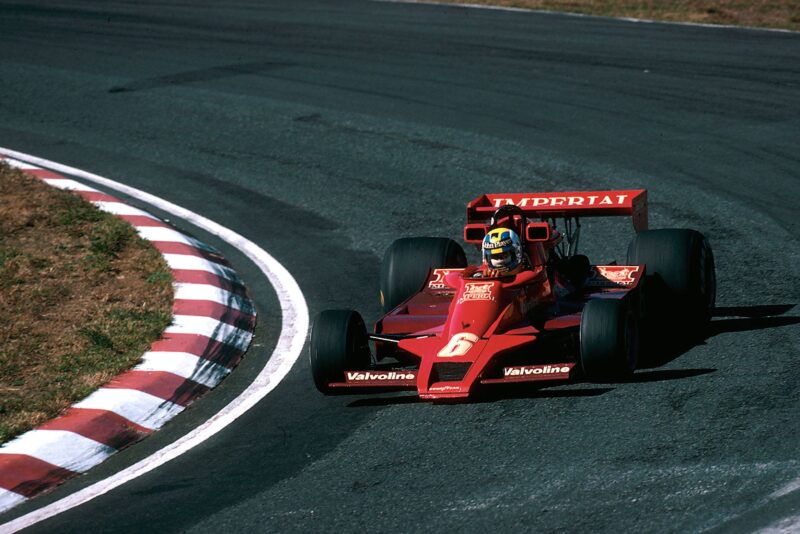
Gunnar Nilsson running a special red Imperial Tobacco livery on his Lotus
Motorsport Images
Hunt was running superbly and there was quite obviously nobody to catch him while Mass was doing an excellent “back up” job in second place just in front of Watson. Then came Scheckter and Regazzoni while Reutemann worked his way to the head of the sixth place bunch by the end of lap zo, Stuck dropping away as his tyres started to go off and eventually dropping into the pits to change the whole set on the Brabham four laps later.
Then, within two laps, Regazzoni suddenly found himself promoted unexpectedly to third place. At the end of the 28th lap Mass’s McLaren had just crossed the start/finish line when its engine blew up spectacularly in a cloud of smoke and steam. The German driver coasted to a standstill at the end of the pit lane and walked back to the pits, bitterly disappointed that his very last drive for the McLaren team should have ended on such a disappointing note. John Watson had less than a lap to enjoy second place for the gearbox of his Brabham suddenly began playing up and eventually refused to select any gears. At the end of the 29th lap he pulled into the pits to retire, so Regazzoni now looked secure in third place behind Scheckter.
With Scheckter obviously in dire handling trouble, prospects looked bright for Regazzoni and Team Ensign. Little by little he closed in on the Wolf and was right up in the blue car’s slipstream as he came up to complete the 43rd lap. As he crossed the start/finish line Regazzoni nipped out to the right of the Wolf and “sat it out” with Scheckter all the way down into the first right hander after the pits. The plucky South African driver didn’t want to give way, but “Regga” had the inside line and there was no way in which he was going to be prevented from taking second place. At the end of the lap on which he was passed by the Ensign, Scheckter bought the Wolf into the pits for a fresh set of tyres and an adjustment to the rear wing in an attempt to cure the car’s now near-terminal understeer. He charged back into the race, well back, but started to lap much more quickly, obviously much happier with the car’s handling.
Regazzoni, sadly, was not destined to take the second place that he’d worked so hard to gain. For ten laps the Ensign circulated in second place, well ahead of Reutemann’s Ferrari which was now consolidating third place in the face of an attack by Laffite. The Ensign had been leaking oil on right handers for some distance and the lubricant was used up by lap 43, the oil pressure vanished and Regazzoni dropped out for good with 43 laps completed.
Five laps later and possession of second place changed yet again as the hard-charging Laffite forced his Ligier past Reutemann’s Ferrari. Nilsson was now a fighting fourth, fending off a strong challenge front Jones’s Shadow, while Depailler was sixth in front of l’atrese. It now looked as though the final race pattern had been finally resolved with just under 30 laps to go.
Unfortunately there was to be one more disappointment, this time for the determined Nilsson who seemed desperate to finish his season with lotus on a decent note. On lap 58 he gave best to Jones, struggling with his gearbox as he did so, and then relinquished fifth place to Depailler on lap 67. On the next lap the disappointed Swede pulled into the pits to retire. His Lotus’s gearbox was becoming increasingly reluctant to select any gear and, for the last few laps. Nilsson had been ramming them in with such brute force that the actual gear linkage in the cockpit was distorted. Sadly, it was a vain effort and eventually the Swede couldn’t select any gears worth having.
There was one last twist to the Japanese Grand Prix. Jacques Laffite’s Ligier ran out of petrol on the very last lap, promoting Reutemann back into a very lucky second place and Depailler, who had forced a way past Jones on lap 66, into third. Laffite was eventually classified fifth ahead of young Patrese who had driven his best race to date in the Shadow DN8.
Seventh was Stuck, after his pit stop, ahead of Brambilla’s Surtees (delayed after two pit stops for a change of plugs), Takahashi, Scheckter, Hoshino and Ribeiro. In the closing stages of the race Scheckter set the race’s fastest lap, beating Laffite’s record from last year, a record incorrectly awarded to Hasenn’s Kojiuia at the time.
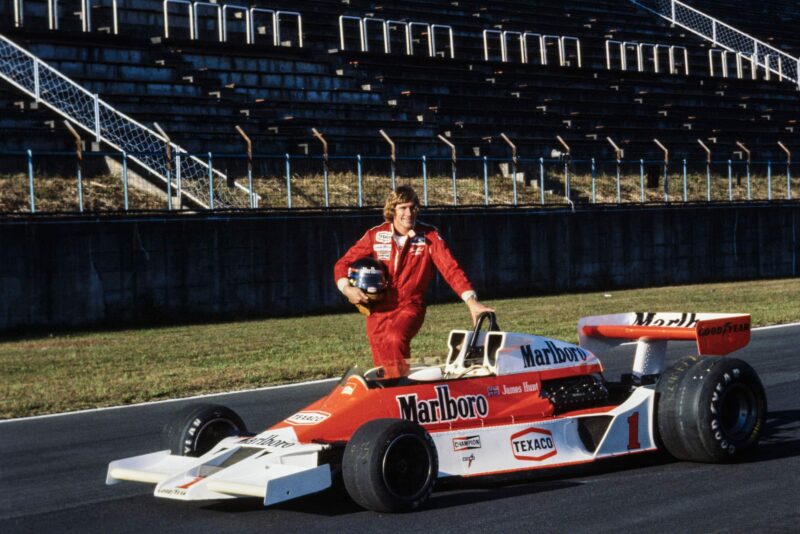
James Hunt left before the podium ceremony took place, so we’ll make do with this end-of-season snapshot
Motorsport Images
But none of them could touch the superb Hunt. The McLaren team leader had been in a class of his own from the word go, proving that he is a fighter and never gives up trying. Unfortunately he made himself rather unpopular with the local dignitaries by failing to appear on the winner’s rostrum and leaving the circuit immediately the race was over in order to catch a plane back to Britain that same evening. Reutemann failed to appear either, although he was still at the circuit. Hunt received a great deal of criticism for his apparently thoughless act but, disregarding this lapse, he certainly dominated the race in as impressive a fashion as anybody has managed in any Grand Prix this season. And, in the end, the “name of the game” is still winning we think.
A.H.
